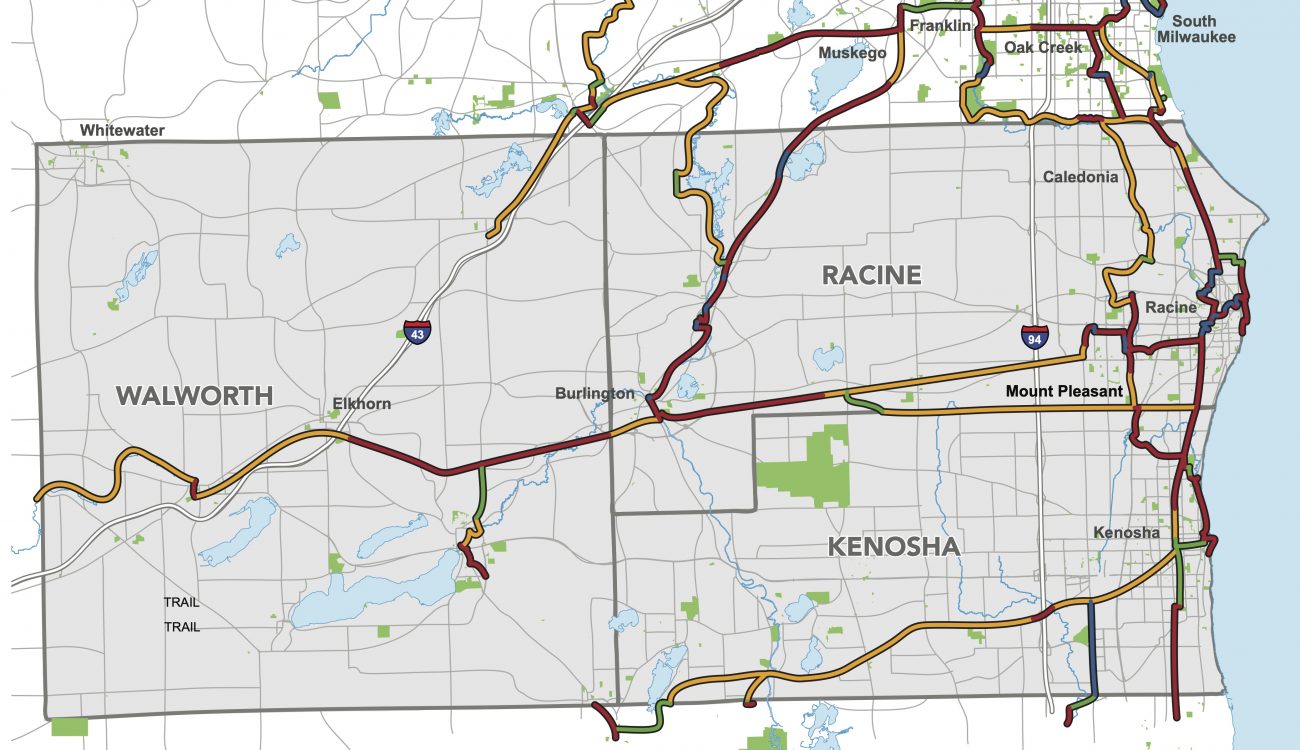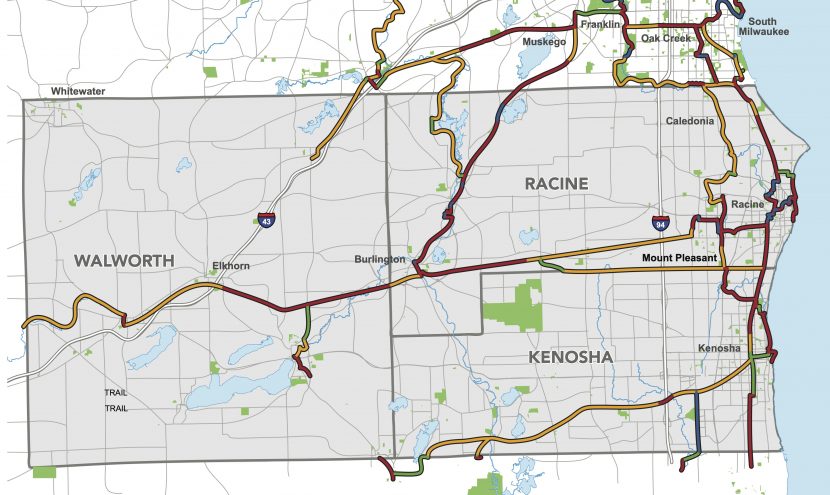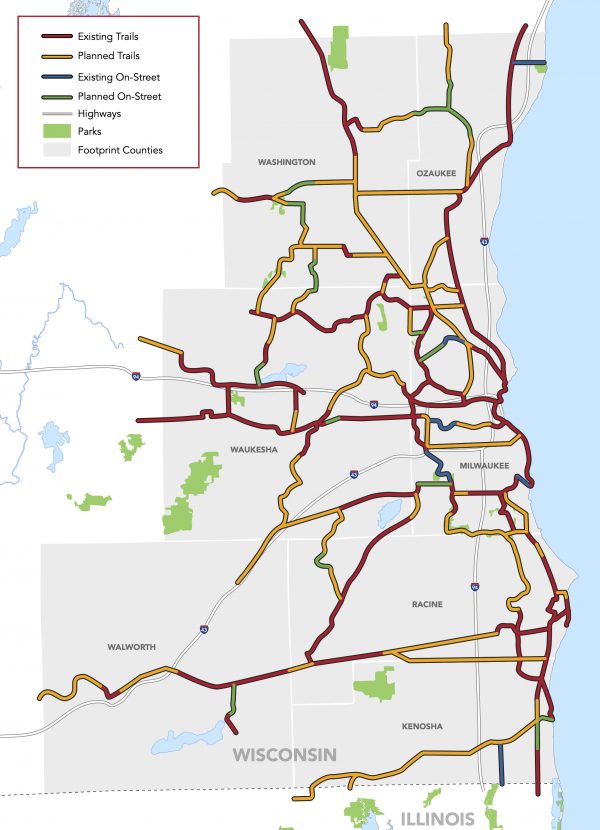
Route of the Badger
Progress made despite pandemic
Progress made despite pandemic
The Route of the Badger (ROTB) is a Milwaukee-area trail system project designed to merge current trail and on-street infrastructure with new trail and on-street facilities to create a seamless 700-mile connected network.
An initiative of the Rails-to-Trails Conservancy (RTC), the Bike Fed and the Southeastern Wisconsin Regional Planning Commission (SEWRPC), the ROTB is one of RTC’s eight TrailNation projects throughout the country. TrailNation projects bring to life RTC’s vision of trails at the heart of healthy, thriving communities from coast to coast.
“All of this is challenging, especially when it is difficult to sit down face to face over coffee.”
Willie Karidis
But all good things take time. — a commonality shared between all eight of the TrailNation projects. But progress does indeed happen as long as you stay committed to the cause and you are able to build relationships with the people who are touched by a given trail project. All of this is challenging, especially when it is difficult to sit down face to face over coffee.
COVID-19’s effects run deep, and trails were not immune to the pandemic. In March and April 2020, RTC tracked trail use nationally and saw an explosion of activity — a 200% average increase nationally. That total has since slowed to a 50% increase in trail use over previous years. Since pandemic restrictions took place, the messaging was clear: It was not only safe, but encouraged, to spend time outdoors. Trails, naturally, became magnets for activity.
The importance of the ROTB has never been more apparent. New places to explore are in high demand, so it’s fortunate that progress for the development of ROTB can be reported. Here are a few highlights.

CP Corridor Funding
Racine County announced it would invest $500,000 to purchase the 10.7-mile CP Corridor that will extend the eastern end of the White River State Trail into Sturtevant. With another $1 million already dedicated to this acquisition, the Wisconsin Department of Natural Resources now has the needed funds to finalize the purchase from the Canadian Pacific Railroad. If all goes to plan, the final documents will be completed in May and then the work of design, engineering and construction will follow. As can never be emphasized enough, trails take a long time to build.
New TAP Projects
New projects that were funded through the federal Transportation Alternative Program (TAP) in the ROTB footprint show great promise for the future of trails. TAP is a legislative program that was authorized in the 2015 Fixing America’s Surface Transportation Act (FAST Act). All TAP projects require sponsors pay 20% of approved projects costs.
- Waukesha: The Fox River Trail will be expanded from North Brookfield Road to Watertown Plank Road
- Greenfield: The Powerline Trail, connecting the Oak Leaf Trail at Coldspring Road, will run west under the interstate, turn north to run parallel with Hwy. 894 to the WE Energies powerline, then turn east along the powerline to 60th Street
- Milwaukee: An on-street protected lane from Lincoln Avenue to Maple Street will serve as an extension of the KK River Trail
- Milwaukee: 20th Street Corridor, WE Energies easement, Olive Street to Meaux Park
- Milwaukee: 20th Street between Purdue Street and West Cornell Street, NW to 24th Street, extension of the Beerline Trail
- Milwaukee County: Drexel Avenue to Ryan Road
- Milwaukee County: Bender Park
- Milwaukee County: Kohl Park
All of these projects are within the ROTB network with construction planned to start on some in 2023.

30th Street Industrial Corridor
In addition to these funded trail projects, a preliminary feasibility study (PFS) was completed in October 2020. The goal of the study was to determine whether the 30th Street Industrial Corridor rail line is able to support a parallel trail. The study takes into account pinch points, land ownership, bridges and street crossings. In the end, it was determined that a trail can co-exist with the existing rail line with potential on-street connections in areas of significant pinch points. The PFS recommended as a next step the development of a community-driven equitable development plan which will be led by the 30th Street Industrial Corridor Corp.
The project is a partnership with the City of Milwaukee, Milwaukee County, Wisconsin Department of Transportation, Milwaukee Metropolitan Sewer District, Northwest Side Community Development Corp., Villard Avenue Business Improvement District, Havenwoods Economic Development Corp., Near West Side Partners, Urban Ecology Center and the Rails-to-Trails Conservancy.
As 2021 unfolds, the ROTB continues to contribute to building healthy and thriving communities in southeast Wisconsin centered around a world-class, 700-plus-mile regional trail system that connects people across towns and counties and provides transformational opportunities for physical activity, tourism, connections to nature, recreation and stronger businesses along the route.
Willie Karidis is project manager for Route of the Badger. Visit railstotrails.org/badger for more info.